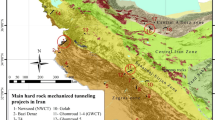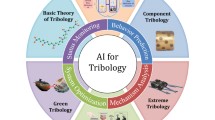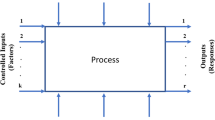Abstract
In view of the importance and difficulty of obtaining suitable rock mechanical parameters for rock, rotary penetration technology combines the advantages of the cone penetration test with rotary cutting, providing a new path towards collecting the relevant data. Indoor tests using a hollow drill have shown that differences in the sample material will not affect the results of rotary penetration tests. This paper introduces the theory that psychological factors will cause some deviation of the selection results and thus that the results need to be modified according to these psychological factors. A fast, intelligent integrated rotary penetration system contains the three modules of a psychological system, expert system, and neural network and can rapidly determine the mechanical parameters of rock and the level of engineering rock mass. The system is feasible and promising, providing detailed and accurate information for engineering predictions and design.










Similar content being viewed by others
References
Alippi C, Boracchi G, Roveri M (2016) A reprogrammable and intelligent monitoring system for rock-collapse forecasting. IEEE Syst J 10(2):733–744. https://doi.org/10.1109/JSYST.2015.2429913
Feng XT (2000) Intelligent rock mechanics. Science Press, Beijing
Feng XT (2002) Development of intelligent rock mechanics. J Chin Acad Sci 4:256–259
Gao W, Chen J, Yue ZQ (2008) Identification of geological interfaces from drilling process monitoring in ground investigation. In: Proceedings and monographs in engineering water and earth sciences, international young scholars symposium on rock mechanics, pp 7–12
Garaga A, Latha GM (2010) Intelligent prediction of the stress-strain response of intact and jointed rocks. Comput Geotech 37(5):629–637. https://doi.org/10.1016/j.compgeo.2010.04.001
Imaizumi A, Matsuo Y, Sakata T et al (2014) Psychological investigation of time estimation for underground space design in rock engineering. In: ISRM international symposium—8th Asian rock mechanics symposium, ARMS 2014, pp 1247–1254.
Kahraman S, Balci C, Yazici S et al (2000) Prediction of the penetration rate of rotary blast hole drills using a new drillability index. Int J Rock Mech Min Sci 37(5):729–743
Sun J (1998) Some progress of rock mechanics research at the turn of the century. In: Lu P, Shi Y (eds) Proceedings of the 6th National geotechnical numerical analysis and analytical method conference. Guangdong Science and Technology Press, Ltd., Guangzhou, pp 1–15
Singh TN, Verma AK (2012) Comparative analysis of intelligent algorithms to correlate strength and petrographic properties of some schistose rocks. Eng Comput 28(1):1–12. https://doi.org/10.1007/s00366-011-0210-5
Tan ZY, Cai MF, Yue ZQ et al (2006a) Theory and approach of identification of ground interfaces based on rock drillability. J Univ Sci Technol Beijing 28(9):803–807
Tan ZY, Cai MF, Yue ZQ et al (2006b) Interface identification of intricate weathered granite ground investigation in Hong Kong using drilling parameters. Chin J Rock Mech Eng 25(S1):2939–2945
Tan ZY, Wang SJ, Cai MF (2008) Study on discriminant classification method for ground formation in identification of geotechnical engineering interfaces. Chin J Rock Mech Eng 27(2):316–322
Xue YD, Gao DL, Huang HW (2008) Analysis of time-series characteristics of strata drillability of pilot drilling for Chinese continental scientific drilling. Chin J Rock Mech Eng 27(1):102–107
Yue ZQ, Li CF, Luo JT et al (2002) Use of HKU drilling process monitor in slope stabilization. Chin J Rock Mech Eng 21(11):1685–1690
Zheng DS, Gao DL, Feng JP (2012) A model for downhole rock drillability prediction under real drilling condition. Rock Soil Mech 33(3):859–864
Acknowledgements
The study is supported by the Shaanxi key science and technology innovation team (2016KCT-23).
Author information
Authors and Affiliations
Corresponding author
Rights and permissions
About this article
Cite this article
Lei, G., Han, J. & Li, Q. Intelligent Analysis on Introducing Psychological Factors into Rotary Penetration Technology. Iran J Sci Technol Trans Civ Eng 45, 373–380 (2021). https://doi.org/10.1007/s40996-020-00506-6
Received:
Accepted:
Published:
Issue Date:
DOI: https://doi.org/10.1007/s40996-020-00506-6




